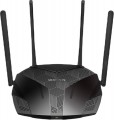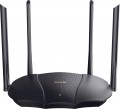Gain
Gain provided by each device antenna; if the design provides for antennas with different characteristics (a typical example is both external and internal antennas), then the information, usually, is indicated by the highest value.
Amplification of the signal in this case is provided by narrowing the radiation pattern — just as in flashlights with adjustable beam width, reducing this width increases the illumination range. The simplest omnidirectional antennas narrow the signal mainly in the vertical plane, "flattening" the coverage area so that it looks like a horizontal disk. In turn, directional antennas (mainly in specialized access points, see "Device type") create a narrow beam that covers a very small area, but provides a very solid gain.
Specifically, the gain describes how powerful the signal is in the main direction of the antenna compared to an perfect antenna that spreads the signal evenly in all directions. Together with the power of the transmitter (see below), this determines the total power of the equipment and, accordingly, the efficiency and range of communication. Actually, to determine the total power, it is enough to add the gain in dBi to the transmitter power in dBm; dBi and dBm in this case can be considered as the same units (decibels).
In general, such data is rarely required by the average user, but it can be useful in some specific situations that specialists have to deal with. Detailed calculation methods for suc...h situations can be found in special sources; here we emphasize that it does not always make sense to pursue a high antenna gain. First, as discussed above, this comes at the cost of narrowing the scope, which can be inconvenient; secondly, too strong a signal is also often undesirable, for more details see "Transmitter power".
2.4 GHz antennas
The total number of antennas in the router that are responsible for communication in the 2.4 GHz band. For details about the number of antennas, see "Total antennas", about the range — "Frequency range".
5 GHz antennas
The total number of antennas in the router that are responsible for communication in the 5 GHz band. For details about the number of antennas, see "Total antennas", about the range — "Frequency range".
Transmitter power
Rated power of the Wi-Fi transmitter used in the device. If multiple bands are supported (see “Ranges of operation”) the power for different frequencies may be different, for such cases the maximum value is indicated here.
The total transmitting power provided by the device directly depends on this parameter. This power can be calculated by adding the transmitter power and the antenna gain (see above): for example, a 20 dBm transmitter coupled with a 5 dBi antenna results in a total power of 25 dBm (in the main antenna coverage area). For simple domestic use (for example, buying a router in a small apartment), such details are not required, but in the professional field it often becomes necessary to use wireless devices of a strictly defined power. Detailed recommendations on this matter for different situations can be found in special sources, but here we note that the total value of 26 dBm or more allows the device to be classified as equipment
with a powerful transmitter. At the same time, such capabilities are not always required in fact: excessive power can create a lot of interference both for surrounding devices and for the transmitter itself (especially in urban and other similar conditions), as well as degrade the quality of the connection with low-power electronics. And for effective communication over a long distance, both the equipment itself and external devices must have the appropriate power (which is far from alway
...s achievable). So, when choosing, you should not chase the maximum number of decibels, but take into account the recommendations for a particular case; in addition, a Wi-Fi amplifier or MESH system often turns out to be a good alternative to a powerful transmitter.Signal strength 2.4 GHz
The power of the transmitter installed in the equipment when operating in the 2.4 GHz band (see "Frequency Band").
This parameter directly affects the overall power and, accordingly, the communication efficiency. For more on this, see p. "Transmitter power" above, but here we separately emphasize that high power is not always required, and in some cases it is frankly harmful.
Signal strength 5 GHz
The power of the transmitter installed in the equipment when operating in the 5 GHz band (see "Frequency Band").
This parameter directly affects the overall power and, accordingly, the communication efficiency. For more on this, see p. "Transmitter power" above, but here we separately emphasize that high power is not always required, and in some cases it is frankly harmful.
CPU
The model of the processor installed in the device.
The processor is responsible for processing network traffic and running software. Knowing its name, you can get more detailed data on the speed capabilities of the equipment and understand how much such a powerful or, on the contrary, mediocre element is needed on board. In new models of Wi-Fi equipment, coprocessors or so-called NPU modules are often installed, which relieve the load from the main processor.
Most often, Wi-Fi equipment is equipped with processors from
Broadcom,
MediaTek,
Realtek and
Qualcomm.
Clock Speed
The number of cycles per second that the processor produces in its normal operating mode. A clock is a single electrical impulse used to process data and synchronize the processor with the rest of the computer system. Different operations may require fractions of a clock or several clocks, but anyway, the clock frequency is one of the main parameters characterizing the performance and speed of the processor — all other things being equal, a processor with a higher clock frequency will work faster and better cope with significant loads.

